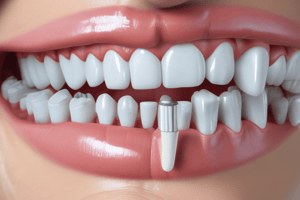Podcast
Questions and Answers
What is the shape of the enamel rods in transverse section?
What is the shape of the enamel rods in transverse section?
- Oval
- Keyhole (correct)
- Circular
- Triangular
What is the average thickness of the apatite crystals in enamel rods?
What is the average thickness of the apatite crystals in enamel rods?
- 10 nanometer
- 100 nanometer
- 50 nanometer
- 30 nanometer (correct)
How many ameloblasts contribute to the formation of each enamel rod?
How many ameloblasts contribute to the formation of each enamel rod?
- 2
- 4 (correct)
- 3
- 5
What is the direction of enamel rods in relation to the dentin surface?
What is the direction of enamel rods in relation to the dentin surface?
What is the characteristic appearance of each enamel rod due to the presence of dark lines?
What is the characteristic appearance of each enamel rod due to the presence of dark lines?
What is the length of each segment of an enamel rod?
What is the length of each segment of an enamel rod?
What is the shape of the calcium phosphate unit cell in apatite crystals?
What is the shape of the calcium phosphate unit cell in apatite crystals?
What is the direction of enamel rods in the cusp region of deciduous teeth?
What is the direction of enamel rods in the cusp region of deciduous teeth?
What is the fundamental structural unit of enamel?
What is the fundamental structural unit of enamel?
What is the shape of enamel rods in cross-section under a light microscope?
What is the shape of enamel rods in cross-section under a light microscope?
What is the clinical significance of gnarled enamel?
What is the clinical significance of gnarled enamel?
What is the boundary between rod and inter-rod enamel composed of?
What is the boundary between rod and inter-rod enamel composed of?
What is the shape of the prism in enamel rods?
What is the shape of the prism in enamel rods?
What is the origin of Hunter-Schreger bands?
What is the origin of Hunter-Schreger bands?
What is the direction of crystals in the inter-rod region?
What is the direction of crystals in the inter-rod region?
What do incremental lines in enamel represent?
What do incremental lines in enamel represent?
What is the appearance of enamel rods when cut in an oblique plane?
What is the appearance of enamel rods when cut in an oblique plane?
What is the term for the organic material between the rod and inter-rod enamel?
What is the term for the organic material between the rod and inter-rod enamel?
What is the characteristic of enamel rods under light?
What is the characteristic of enamel rods under light?
What is the characteristic of Hunter-Schreger bands?
What is the characteristic of Hunter-Schreger bands?
Where do enamel rods originate from?
Where do enamel rods originate from?
What is the direction of the incremental lines in a longitudinal section of the tooth?
What is the direction of the incremental lines in a longitudinal section of the tooth?
What is the term for the optical appearance of enamel when cut in an oblique plane?
What is the term for the optical appearance of enamel when cut in an oblique plane?
What is the characteristic of gnarled enamel in the cervical region?
What is the characteristic of gnarled enamel in the cervical region?
Flashcards are hidden until you start studying
Study Notes
Enamel Rods
- Enamel rods have a keyhole shape in transverse section.
- Each rod has a head formed by the rod, commonly directed towards the incisal or occlusal aspect, and a tail formed by interrod, directed towards the cervical region of the teeth.
- Each rod is formed by four ameloblasts, contributing to four different rods.
Structure of Enamel Rods
- Enamel is built from closely packed and long ribbon-like crystals, specifically apatite crystals.
- The length of these crystals ranges from 0.05 to 1 micrometer, with an average thickness of 30 nanometers and a width of 90 micrometer.
Course of Enamel Rods
- Enamel rods run a tortuous course from the dentino-enamel junction (DEJ) to the enamel surface.
- The rods have an oblique direction and wavy course, with their length greater than the thickness of the enamel.
- Rods in the cusp region are longer than those in the cervical region.
Striations
- Each enamel rod is built of segments separated by dark lines, giving it a striated appearance.
- The segments are approximately 4 micrometer in length.
Direction of Rods
- Enamel rods are oriented at right angles to the dentin surface.
- In deciduous teeth, the rods are approximately horizontal in the central part, and increasingly oblique in the cusp and incisal regions.
- In permanent teeth, the rods are similar in the occlusal third, and deviate from horizontal in an apical direction in the cervical region.
Gnarled Enamel
- Gnarled enamel appears when the disks are cut in an oblique plane, especially near the dentin, leading to an optical appearance of enamel rods intertwining irregularly.
Clinical Significance
- The irregular twist and intertwining of enamel rods may be associated with increased strength of enamel, enabling it to withstand strong masticatory forces.
Hunter Schreger Bands
- Hunter Schreger bands originate at the DE border and pass outward, ending at some distance from the outer enamel surface.
- These bands consist of alternate zones of slightly different permeability and organic material content.
Incremental Lines / Striae of Retzius
- These are incremental growth lines in enamel, representing the rhythmic deposition of enamel.
- In longitudinal sections of the tooth, they appear as a series of dark lines extending from the dentinoenamel junction toward the tooth surface.
Surface Structures
- Enamel cracks
- Enamel lamellae
- Neonatal lines
- Enamel spindles
- Gnarled enamel
- Enamel tufts
- Dentinoenamel junction
- Odontoblastic processes
Studying That Suits You
Use AI to generate personalized quizzes and flashcards to suit your learning preferences.



